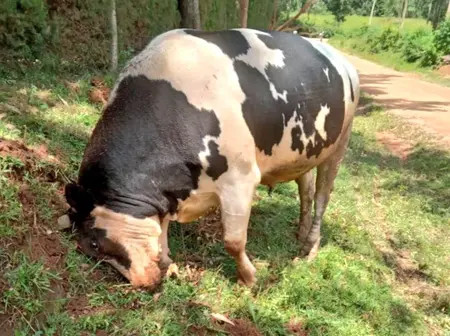Kakamega senator Boni Khalwale is gearing up for the bullfighting season with a new bull called Mung’onya. Khalwale is known for his long-time passion for the sport, which has earned him the moniker ‘the bullfighter’.
The senator announced the news on Twitter, saying that the bull will be facing off with ‘Nyota’, its rival and the Idakho East champion.
Mung’onya is a relatively new entrant into the realm of bullfighting, given that this will be his first ‘baptism of fire’ in public.
The bull is a replacement for Khalwale’s former prizefighter bull called Inasio, which was the regional champion in the Ikolomani bullfighting contests until 2024.
Tragically, Inasio killed its longtime caretaker and trainer, Kizito Moi, who had worked with Khalwale for 24 years.
Following the incident, Senator Khalwale speared Inasio to death in accordance with Luhya cultural traditions, which dictate that when a fighting bull kills a person, it is subsequently killed and its body parts shared traditionally.
From Inasio, Khalwale introduced another bull called Lumumba in 2024, saying that ‘The Luhya community abhors a vacuum’. However, it seems that Lumumba has also found his replacement.
The new challenger
Based on the images that Khalwale posted on social media, Mung’oya appears to have a black and white color pattern, which is characteristic of breeds like the Holstein or a crossbreed involving Holstein genetics.
Holstein cattle originate from the Frisian region in northern Europe and are the dominant breed in industrial dairy farming globally.
Bullfighting is common among the Luhya community, especially among the Isukha and Idakho subtribes who live near the Kakamega East District bordering Nandi and Vihiga counties. However, the event is also common among the Wanga and Kabras subtribes, albeit at a more low-key level.
In a past interview with TUKO, Mr. Bonaventure Munanga – Shinyalu’s bullfighting chairman – revealed that bullfighting in the Luhya community is not only a sport but is rather a revered cultural event practiced in weddings and burial ceremonies.
The bull-fighting event begins with the selection of a young, well-fed, healthy bull, which is then named according to current events, such as art and politics. The bull’s horns are also sharpened to increase its chances of goring its opponent.
According to Mr. Munanga, the owner of the bull is prohibited from sharing a meal or sleeping with his wife for a fortnight before the bullfighting event. This is done to protect the bull from ‘evil spirits’ which may diminish its performance during the match.
The bulls are also prohibited from mating 3 weeks before the event in an effort to conserve their energy and focus. Mating might also expose them to sexually transmitted diseases, which may limit their performance during the match.
Contrary to popular belief, the bulls are not made to consume bhang or any stimulants. “If you give him bhang instead of fighting, he will start hitting the fans on the field or even run away and destroy things,” said Mr. Austin Munase, a bull owner.
Aside from the Luhya community in Kenya, bullfighting is popular in Portugal, France, Mexico, Colombia, Peru, India, Ethiopia, Kenya, Sudan, Nigeria, China, and parts of Southeast Asia.

Leave a Reply